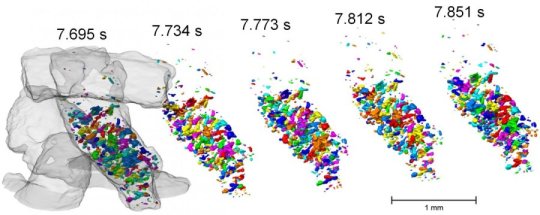[ad_1]
The quality of materials often depends on the manufacturing process. In casting and welding, for example, the rate at which melts solidify and the resulting microstructure of the alloy is important. With metallic foams as well, it depends on exactly how the foaming process takes place. To understand these processes fully requires fast sensing capability. The fastest 3D tomographic images to date have now been achieved at the BESSY II X-ray source operated by the Helmholtz-Zentrum Berlin.
Dr. Francisco Garcia-Moreno and his team have designed a turntable that rotates ultra-stably about its axis at a constant rotational speed. This really depends on the highest precision: Any tumbling around the rotation axis or even minimal deviations in the rotation speed would prevent the reliable calculation of the 3D tomography. While commercially available solutions costing several hundred thousand euros allow up to 20 tomographic images per second, the Berlin physicists were able to develop a significantly cheaper solution that is even faster. “My two doctoral students at the Technische Universität Berlin produced the specimen holders themselves on the lathe,” says Garcia-Moreno, who not only enjoys working out solutions to tricky technical problems, but possesses a lot of craftsman skill himself as well. Additional components were produced in the HZB workshop. In addition, Garcia-Moreno and his colleague Dr. Catalina Jimenez had already developed specialized optics for the fast CMOS camera during the preliminary stages of this work that allows even for simultaneous diffraction. This makes it possible to record approximately 2000 projections per second, from which a total of 25 three-dimensional tomographic images can be created.
As a first example, the team investigated granules of aluminium alloys that become a metallic foam when heated. To do this, they mounted a powerful infrared lamp above the metal granulate to heat the sample to about 650 degrees Celsius. A complete 3D tomographic image with spatial resolution of 2,5 micrometers (pixel size) was generated every 40 milliseconds. The nearly 400 tomographic 3D images now allow detailed, time-resolved analysis of the process as it occurred,.
“We wanted to develop a better understanding of how pores form in the grains — whether they also reach the granule surfaces and to what extent this process varies in different granules,” explains Garcia-Moreno. It is a question of practical relevance that is also of interest to industry. This is because granules of metallic compounds might fill complicated shapes better while foaming than foams manufactured from a block of metal. However, the moulded part will only be able to withstand stress if the grains also bond closely with one another during foaming. With the ultra-fast 3D tomography developed at BESSY II, this can now be observed very precisely — as well as a multitude of other dynamic processes.
Since the EDDI beamline must be dismantled for the upgrade from BESSY II to BESSY-VSR, Garcia-Moreno has contacted other X-ray sources and plans to establish this method at those locations.
Story Source:
Materials provided by Helmholtz-Zentrum Berlin für Materialien und Energie. Note: Content may be edited for style and length.
[ad_2]















